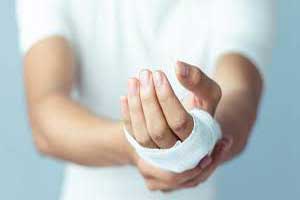- Home
- Editorial
- News
- Practice Guidelines
- Anesthesiology Guidelines
- Cancer Guidelines
- Cardiac Sciences Guidelines
- Critical Care Guidelines
- Dentistry Guidelines
- Dermatology Guidelines
- Diabetes and Endo Guidelines
- Diagnostics Guidelines
- ENT Guidelines
- Featured Practice Guidelines
- Gastroenterology Guidelines
- Geriatrics Guidelines
- Medicine Guidelines
- Nephrology Guidelines
- Neurosciences Guidelines
- Obs and Gynae Guidelines
- Ophthalmology Guidelines
- Orthopaedics Guidelines
- Paediatrics Guidelines
- Psychiatry Guidelines
- Pulmonology Guidelines
- Radiology Guidelines
- Surgery Guidelines
- Urology Guidelines
Novel electric field-based dressing helps heal wound infections faster

Researchers at Indiana University School of Medicine have developed a dressing that uses an electric field to disrupt biofilm infection. This is a new way to charge up the fight against bacterial infections using electricity. The findings of the study have been published in the journal Annals of Surgery.
The Centers for Disease Control and Prevention estimates 65 percent of all infections are caused by bacteria with this biofilm phenotype, while the National Institutes of Health estimates that number is closer to 80 percent.
Bacterial biofilms are thin, slimy films of bacteria that form on some wounds, including burns or post-surgical infections, as well as after a medical device, such as a catheter, is placed in the body. These bacteria generate their own electricity, using their own electric fields to communicate and form the biofilm, which makes them more hostile and difficult to treat.
Researchers at IU School of Medicine are the first to study the practice of using an electric field-based dressing to treat biofilms rather than antibiotics. They discovered the dressing is not only successful in fighting the bacteria on its own but when combined with other medications can make them even more effective. This discovery has the potential to create significant changes in the way physicians treat patients with bacterial infections which are resistant to antibiotics. The dressing can also help prevent new biofilm infections from forming in the future. The dressing electrochemically self-generates 1 volt of electricity upon contact with body fluids such as wound fluid or blood, which is not enough to hurt or electrocute the patient.
"This shows for the first time that bacterial biofilm can be disrupted by using an electroceutical dressing," said Chandan Sen, PhD, director of the Indiana Center for Regenerative Medicine and Engineering and associate vice president of research for the IU School of Medicine Department of Surgery. "This has implications across surgery as biofilm presence can lead to many complications in successful surgical outcomes. Such textile may be considered for serving as hospital fabric -- a major source of hospital-acquired infections"
Marketing of the dressing for burn care was recently approved by the Food and Drug Administration. The team is now studying the device's effectiveness in patients recovering from burns.

Disclaimer: This site is primarily intended for healthcare professionals. Any content/information on this website does not replace the advice of medical and/or health professionals and should not be construed as medical/diagnostic advice/endorsement or prescription. Use of this site is subject to our terms of use, privacy policy, advertisement policy. © 2020 Minerva Medical Treatment Pvt Ltd